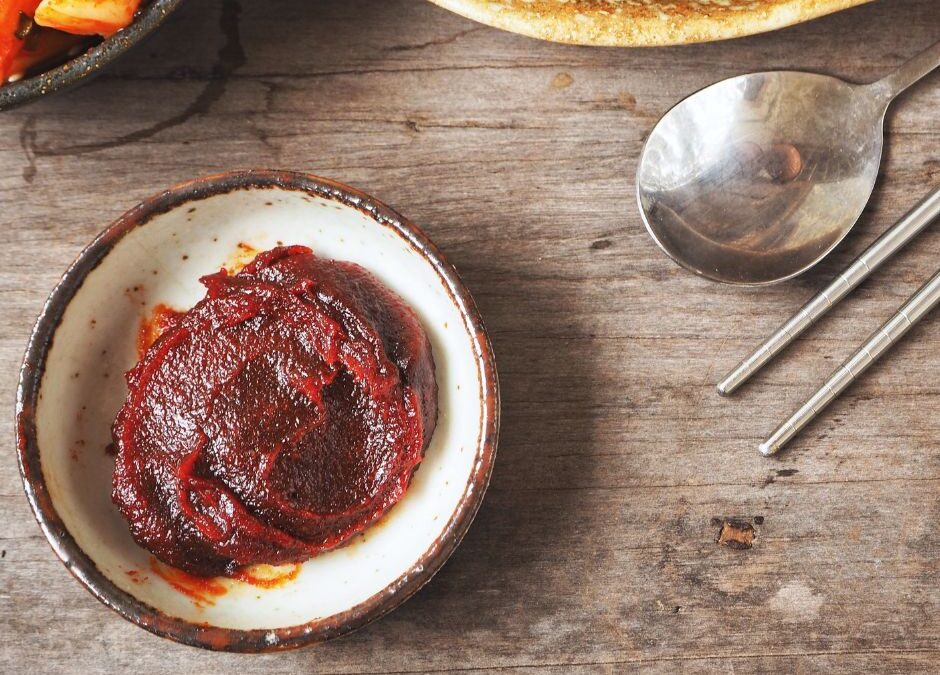Users of our meal-kit service may have already noticed: I love cooking with gochujang paste! Gochujang is a delicious Korean condiment that can spice up your plant-based dishes, adding heat and depth to your meals. This spicy paste has been around for centuries and is now gaining popularity worldwide. In this blog I will explore some of gochujang paste’s history, nutritional benefits, and versatile uses, as well as share three plant-based recipes to get you started.
The History of Gochujang Paste
Gochujang has a long and interesting history. It’s made by fermenting chili peppers, which were brought over to East Asia from the Americas by Portuguese traders in the 16th century. But even before then, Koreans were making spicy sauces and pastes using black peppercorns and Korean or Japanese pepper.
To make gochujang, the peppers are traditionally fermented over several years in earthenware called jangdok. This special clay pot is used to ferment foods like kimchi and to store grains such as rice. The fermentation process gives gochujang its unique and delicious flavour.
By the 18th century, gochujang had become very popular among Koreans who could afford it. In fact, Sunchang County in North Jeolla Province became famous for its gochujang production. To this day, they honour and celebrate the spicy paste during the annual Sunchang Gochujang Festival. Today, gochujang is a hot item and you can see it popping up in many trendy dishes and restaurants all over the world, and for good reasons.
The Nutritional Benefits of Gochujang Paste
Not only is gochujang paste delicious, but it also has many nutritional benefits. It’s a great source of protein, fiber, and vitamins, and contains probiotics that are good for your digestion and immune system. Moreover, Gochujang paste is rich in capsaicin, the compound that gives chili peppers their heat. Capsaicin is a natural pain reliever that can reduce inflammation, boost metabolism, assist with weight loss, and even improve heart health. So, by using gochujang paste in your cooking, you’re not only adding flavor but also providing your body with some amazing health benefits.
How to Use Gochujang Paste in Plant-Based Cooking
Gochujang paste is incredibly versatile. There are so many ways you can use this amazing product in plant-based cooking. Here are some ideas:
Marinades: Use gochujang paste as a marinade for tofu, tempeh, seitan, or any other plant-based protein. Combine gochujang paste with soy sauce, garlic, ginger, and other seasonings for a flavourful and spicy marinade.
Dipping sauces: Mix gochujang paste with vegan mayo or sour cream for a zesty dipping sauce. You can also add a bit of lime juice, sesame oil, or maple syrup for added flavour.
Stir-fries: Add gochujang paste to your stir-fries for a spicy kick. It pairs well with veggies like broccoli, capsicum, and mushrooms, as well as with plant-based proteins like tofu or tempeh.
Salad dressings: Mix gochujang paste with olive oil, rice vinegar, maple syrup, and soy sauce for a delicious and spicy salad dressing.
The possibilities are endless, and you can experiment with different ingredients to create your own unique dishes. Gochujang paste is also a great ingredient to use if you’re trying to cut down on salt or sugar, as it adds flavour without the need for those ingredients.
Plant-Based Gochujang Paste Recipes
Now that you know how to use gochujang paste, let’s get cooking! Here are three plant-based VegMeUp gochujang paste recipes that I have developed for our meal-kit service. Have a look and see for yourself what dish you would like to try.
Korean Bibimbap
This popular Korean dish will really excite you. Not only does the gochujang paste really lift up the flavours it is also full of healthy goodness with plenty of fresh vegetables and brown rice so you know for sure you to get all the nutrition you need.
Gochujang Braised Tofu with Broccolini
Such an explosion of flavours. This plant-based dish is truly exceptional and definitely one of my favourites. Again, the gochujang paste is the star ingredient and really elevates this dish and gives it so much depth. The sauce also includes grated pear which softens the spice delicately. Combined with crunchy broccolini and protein rich tofu, it is a perfect weeknight dinner. If you prefer not to have your meals too spicy, just use half the amount of paste. I am sure you will love this dish!
Korean Style Jackfruit Tacos
Mexican tacos meet Korean spice. This intriguing dish is super fun to cook and eat. The taco filling is made with jackfruit. Jackfruit is an amazing meat replacement since it is a chewy fruit that absorbs flavours like no other. Out of the three dishes this is probably the easiest to cook and won’t take you any longer than 20 minutes. You can find the
I hope this blog about gochujang paste as triggered your curiosity about this amazing Korean product and motivates you to start experimenting.
Let me know if you have some great tips yourself about cooking with this plant-based super ingredient. I would love to hear about from you.
Enjoy your cooking.
With Love,
Jimmy

